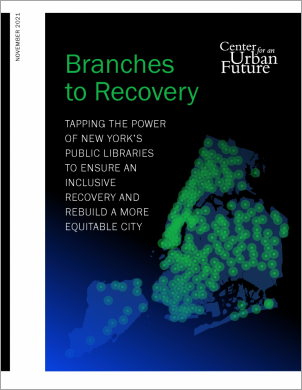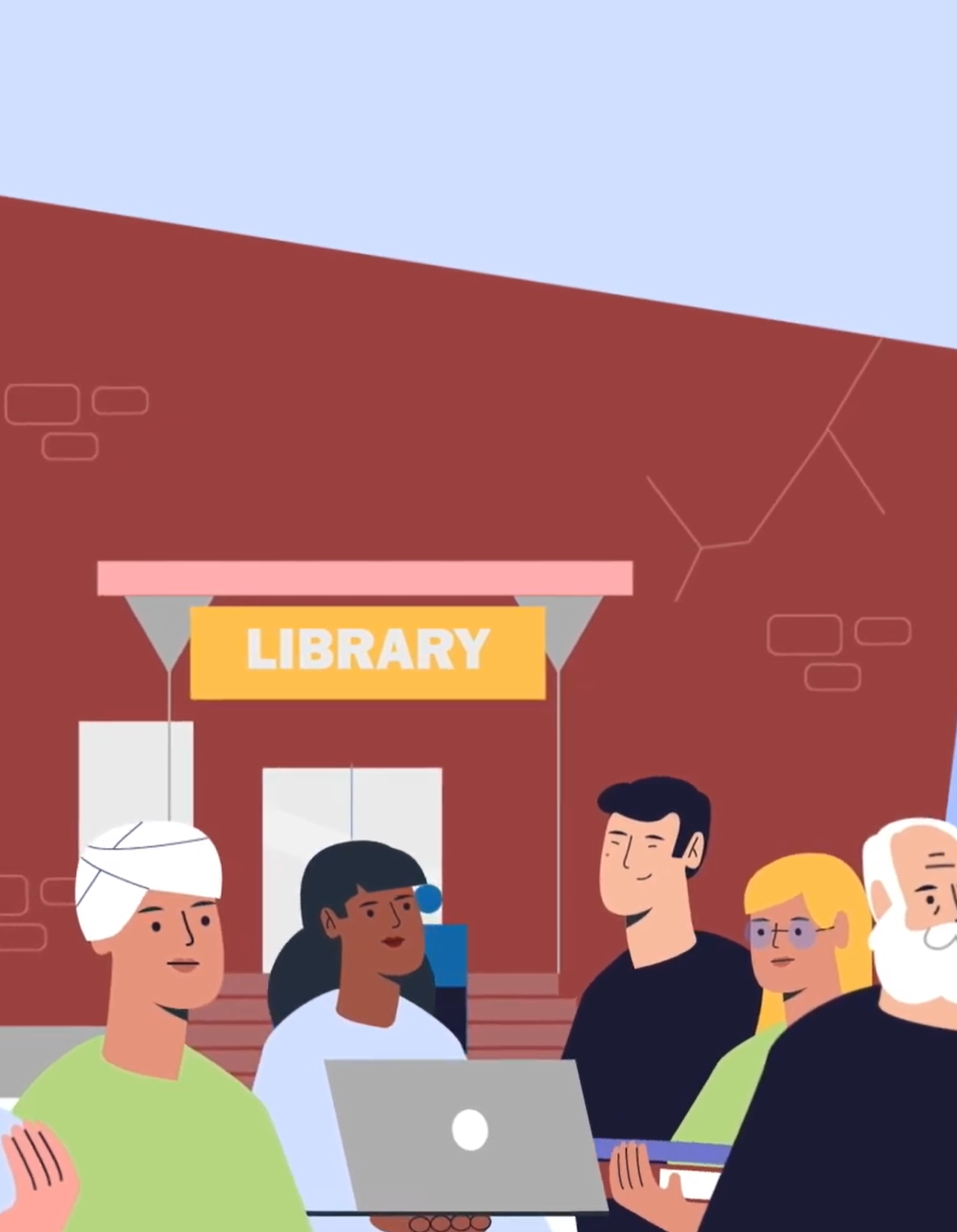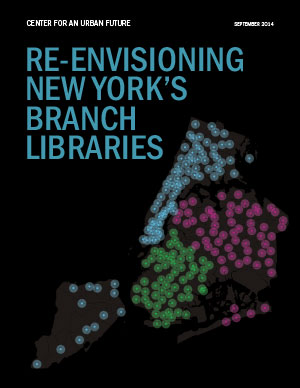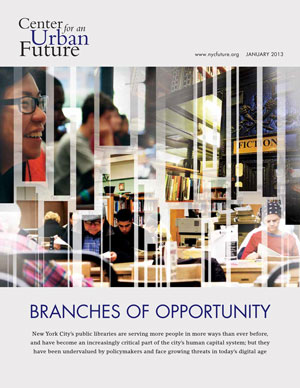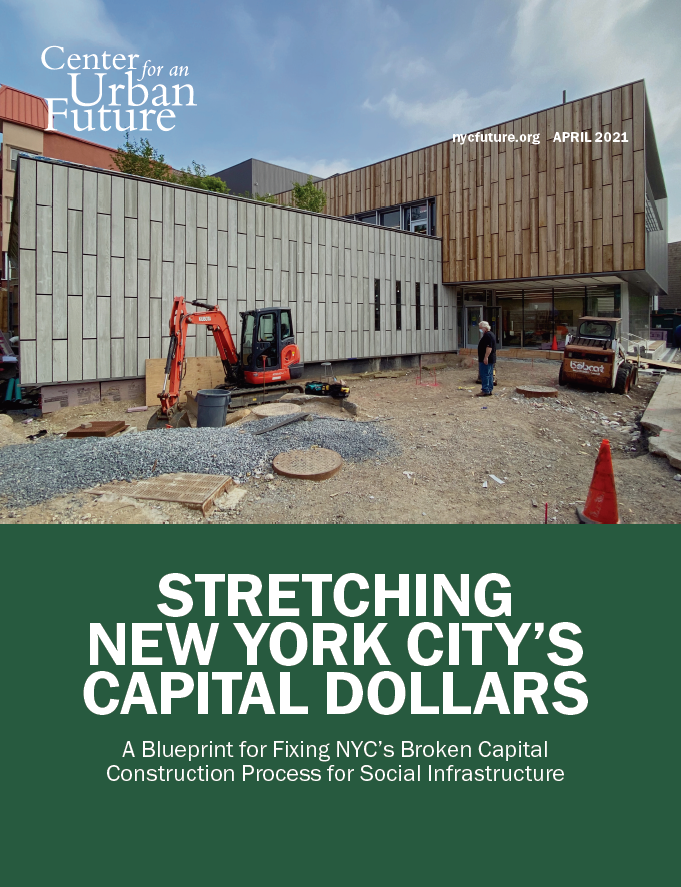- The following are recommendations from Branches to Recovery: Tapping the Power of New York’s Public Libraries to Ensure an Inclusive Recovery and Rebuild a More Equitable City
- Read the full report (PDF)
Equipping NYC’s Branch Libraries to Rebuild a More Equitable City
Over the next five years, New York’s leaders should harness the unparalleled reach, trust, and capabilities of the city’s branch libraries to tackle the greatest challenges facing New Yorkers.
Priority Recommendations
To unlock the full potential of the city’s public libraries to create and sustain a more equitable city for the long term, city leaders should commit to investing $1 billion annually—and focus that investment on achieving the following seven priority recommendations:
- Fund a major expansion of libraries’ hours of operation to extend access to far more working New Yorkers. Expanding open hours will be essential for reaching many of the New Yorkers in greatest need of library services: working families whose only free hours are at night, early in the morning, or on the weekend. Despite considerable improvement in recent years, New York City’s libraries are still open fewer hours than many of the largest library systems in the nation—including Chicago, Dallas, San Diego, and San Antonio—and most of the large counties in New York State. Currently, fewer than 9 percent of the city’s branch libraries are open seven days a week. In fact, New York City’s branch libraries were open fewer hours per week, on average, in the year before the pandemic hit than they were during the Great Depression. An annual investment of $1 billion in the city’s library systems—about 1 percent of the city’s annual budget—can ensure that New York City’s branch libraries lead the nation in weekly hours of operation, making these critical spaces and their resources accessible to far more New Yorkers. In addition, we recommend that at least one branch in each borough be opened 24/7, creating continuous access points to a range of vital services.
- Provide targeted funding for libraries to ramp up their most effective and promising programs and partnerships, reinvent underutilized spaces, and invest in expansion. Policymakers should make targeted investments in specific library programs to keep pace with high need and growing demand. In addition to keeping libraries open longer, an investment of $1 billion annually could dramatically expand early literacy programs and digital skills training, create a network of drop-in homework help centers, launch business plan competitions in multiple languages, expand one-on-one support for jobseekers and small business owners, and reconnect thousands of older New Yorkers after more than a year of painful isolation. Sustained public investment could eliminate waitlists for high-demand programs, maintain popular virtual programming even while returning to in-person service, and enable libraries to act quickly when emergencies arise—whether due to a public health crisis like the COVID-19 pandemic or an environmental catastrophe like a hurricane or flood. This level of investment would also enable the city’s three library systems to reimagine underutilized spaces by implementing and expanding the “kit-of-parts” approach piloted successfully at the Flatbush branch and other architectural solutions to maximize the functionality of small and aging branches.
- Create a dedicated maintenance fund enabling libraries to make critical building fixes before problems can grow. The city’s three library systems face nearly $900 million in repairs and upgrades, including renovations to overhaul heating and cooling systems, fix leaking roofs, patch crumbling masonry, upgrade aging plumbing, and improve accessibility. Capital shortfalls total $418 million at New York Public Library, $251 million at Queens Public Library, and $227 million at Brooklyn Public Library. Although the mayor and City Council have gradually increased capital support for libraries in recent years, libraries are still routinely forced to divert limited public funding away from operations in order to fix leaks, repair boilers, and keep aging branches functioning. The mayor and City Council should create a dedicated maintenance fund to support state-of-good-repair needs across all three systems and help catch smaller problems before they grow.
- Build the future of branch libraries into the city’s 10-year capital plan—and commit to expanding most of the city’s smallest branches by 2033. For the city to fully harness the power of branch libraries in every community, capital investment will need to do much more than chip away at the systems’ mountain of state-of-good-repair needs. Expanding branch-level capacity to offer everything from early literacy programs and dedicated teen spaces to ESOL programs, business plan competitions, and robotics teams will require far more useable space than exists today. Currently, 100 branches across the five boroughs are under 10,000 square feet, severely restricting their capacity and range of uses. These branches should be a top priority for rebuilding and expansion in the city’s long-term capital plan. But current 10-year capital funding is largely intended to cover state-of-good-repair needs for the current system and leaves very little room to invest in much-needed branch expansions and replacements. The city should solicit plans from all three systems to expand most of their smallest and most overcrowded branches and commit sufficient funding in the next 10-year capital plan (FY2024-FY2033) to achieve this.
- Integrate libraries into agency plans to tackle key challenges and ensure an inclusive recovery. Given libraries’ unmatched reach and trust, city agencies should take full advantage of libraries as natural partners to expand uptake for a range of services and develop new programs in high-need communities. But to do so effectively, agency leaders should involve the city’s library systems from the beginning of the planning process and treat branches as true partners in addressing the city’s major challenges. Prior to the pandemic, this rarely happened. Although many city agencies did seek out libraries to help meet their policy goals, too often libraries were brought in at the end of the planning process, missing critical opportunities for libraries to help craft effective partnership strategies. And rarely were libraries given funds to expand services beyond what they were already doing. The Department of Education should look to libraries as a powerful ally in addressing learning loss caused by the pandemic, with the potential for year-round enrichment programs, teen mentorship for younger children, and drop-in homework help throughout the school year. Likewise, the Department of Small Business Services or NYC Economic Development Corporation should make libraries a key partner in plans to boost entrepreneurship in hard-hit communities—sparking the city’s next wave of small business owners and job creators.
- Increase expense funding to support key staff roles that maximize impact. During the course of our research for this report, one key challenge emerged repeatedly: the need to invest in local branch library staff in order to maximize the impact and reach of library programs and services. Even as demand for key programs has surged, libraries are operating with 15 percent fewer staff members than a decade ago. Additional baselined expense funding can enable libraries to hire dedicated outreach librarians in every community and facilitate more partnerships with local community-based organizations, bringing compassionate, culturally competent programming—from early literacy to entrepreneurship training—directly into the spaces and neighborhoods where the New Yorkers hit hardest by the pandemic live, work, and learn.
- Help libraries take some of their vital resources on the road—to homeless shelters, laundromats, public housing complexes, senior centers, and playgrounds. While millions of New Yorkers make their way to branches every year, the city's branch libraries can deepen their impact by bringing some of their invaluable services—and community partnerships—into parts of their neighborhoods where there are unmet needs. This might entail regular storytime readings at homeless shelters and in NYCHA playgrounds, or book club discussions and digital learning sessions at senior centers and in naturally occurring retirement communities (NORCs). New York's libraries had begun to do on a small scale this prior to the pandemic, but there are opportunities to expand these nascent efforts if provided the resources. The mayor and City Council should consider funding a large-scale pilot program to bring library services into community spaces in 2022 as part of efforts to help New Yorkers still reeling from the COVID crisis.
Issue-Specific Recommendations
Ensuring Children & Young Adults Overcome COVID Learning Loss
- Build out drop-in homework help at branches in every hard-hit community. Even before the pandemic, libraries saw exploding demand for their free drop-in homework programs. Today, drop-in help holds even more potential to counter COVID-related learning loss and keep public school students from falling further behind. With city support, this small-scale program should be expanded to branches in every hard-hit community.
Strengthening Minority- and Immigrant-Owned Businesses
- Grow the libraries’ unique business plan competitions. Libraries are home to the city’s only start-up competitions focused on lower-income entrepreneurs, providing a crucial spark to aspiring business owners in many of the communities hit hardest by the pandemic. With additional funding, the libraries’ business plan competitions could take place multiple times per year—instead of just once annually—and new competitions could launch in multiple languages, including Spanish, Chinese, Bengali, Korean, Russian, and Haitian Creole.
- Hire business services librarians to expand in-branch programming and community outreach. Each year, thousands of aspiring entrepreneurs from underserved backgrounds—including women, immigrant, and minority entrepreneurs—seek out free small business and entrepreneurship counseling at the city’s branch libraries. But the library systems are only funded to provide business services at fewer than half of the branch locations citywide. An investment of $1 million annually could triple the number of business outreach librarians and help bring these vital services to every branch across the city.
- Partner with NYCEDC to launch new business incubators in branches citywide. To help spark economic development and new business formation in the communities hit hardest by the pandemic, NYCEDC should partner with libraries to launch new small business incubators. EDC should start by launching five library-based business incubator programs in food, fashion, education, wellness, and home services.
Expanding Access to Tablets, Laptops, and High-Speed Internet
- Expand library capacity to lend laptops and hotspots and provide extended WiFi. In a city where nearly 780,000 households lack a desktop or laptop computer at home and many more don't have home Internet access, branch libraries can help close the divide. The city should provide libraries with the funding to triple the number of Internet-enabled laptops and tablets available for home lending. In 2019, the three library systems combined had just 18,500 Internet-enabled devices to lend. The city can also help close the broadband gap by investing in libraries’ ability to provide expanded WiFi outside the walls of every branch—a resource that fewer than one-quarter of branches across the city are able to provide today.
- Scale up teen tech training programs. Branch libraries are one of the only places where New York City teens can learn hands-on tech skills for free—and gain confidence in pursuing tech-related degrees and careers. But capacity is extremely limited: for instance, each year just 100 teens can participate in BPL’s innovative Today’s Teens, Tomorrow’s Techies program, which teaches teens to help library patrons with their tech needs. City leaders should scale up this program from 100 to 1,000 teens annually and help the other systems launch and scale teen tech training programs of their own.
- Create ten new STEM Centers in branch libraries citywide. Libraries play a critical role in introducing young New Yorkers of all backgrounds to STEM careers—an essential prerequisite for increased diversity among STEM graduates and in STEM jobs. But these initiatives have a lot of room to grow. City leaders should replicate the existing STEM Center at the Washington Heights library—in partnership with the nonprofit NYC FIRST—in ten more branches across the city, expanding free, hands-on instruction in digital fabrication, mechanical engineering, and robotics to thousands more young New Yorkers.
Helping New Yorkers Get Back to Work
- Bring career services to every branch and target additional support to communities with the highest rates of unemployment. Libraries are already among the largest providers of career services, filling major geographic gaps in the city’s landscape of public career support services. But libraries are stretched thin even as demand increases. City leaders can help support far more jobseekers by doubling the number of full-time career services staff at the three systems. A modest additional investment could ensure that libraries have the resources to provide onsite career services specialists in all of the neighborhoods citywide experiencing above average rates of unemployment.
- Make libraries a central hub in the city’s wider network of career services. With the city’s unemployment rate hovering near 9 percent, agency officials should look to libraries as a natural partner in scaling up programming for jobseekers. The next mayor should direct the Department of Small Business Services to launch pop-up Workforce 1 Career Center programs at branches without nearby Centers, greatly expanding the reach of these services. With additional funding to hire staff, branch libraries could host more regular job fairs, expand job search assistance services in multiple languages, and work with industry experts to host intensive career coaching in growing fields like healthcare, tech, construction, and more.
Fostering Economic and Civic Inclusion in Immigrant Communities
- Make ActionNYC available in-person and expand to 25 branches. Recent years have inflicted one crisis after another on New York City’s immigrant communities, from increasing anti-immigrant sentiment to the disproportionate toll of the pandemic. One important source of support is the city’s ActionNYC initiative, which offers free legal services and counseling, but is currently only available virtually. In order to meet growing demand for these services and better support immigrant New Yorkers, city leaders should maintain virtual services while expanding the program to at least 25 branches citywide.
- Replicate popular library programs in multiple languages. Libraries already offer a wide range of programs and services that appeal to many immigrant patrons, from business plan competitions and family literacy workshops to financial aid assistance and career counseling. But the systems have limited resources to offer these programs in multiple languages. City leaders should allocate funding so many of the most popular library programs can be expanded to branches in immigrant communities and provided in languages other than English—and so popular programs already offered in languages from Spanish to Haitian Creole have the capacity to expand.
- Double the number of seats for intermediate and advanced ESOL and expand opportunities for blended online/in-person learning. Scaling up free, career-oriented ESOL training will be essential to expanding access to economic opportunity and mitigating the disproportionate harm done by the pandemic to immigrant communities. Today, the three branch systems provide ESOL training to more New Yorkers than any other institution, but demand for seats—especially for intermediate and advanced adult literacy programs—and blended in-person/online programs far exceeds supply. City leaders should make a targeted investment in doubling the seats for these higher-level ESOL classes, expanding access to tech platforms that support blended learning instruction, and ensure that more immigrant New Yorkers who learn English at the library are able to move into more intensive, career-oriented language classes.
- Extend hours and launch nights and weekends programming in immigrant communities. The reach of branch library programs and services is hampered by hours that limit the ability of many working New Yorkers—especially immigrants—to visit and participate. City leaders should work with the three systems to fund expanded night and weekend hours, especially for branches located in immigrant-dense communities, and ensure that popular programs like intermediate/advanced ESOL are offered during those times.
Closing Academic Achievement Gaps Through Expanded Early Education
- Invest in libraries to help close the gap in early learning for children ages 0-3. Our report identifies nearly 200,000 children ages 0 to 3 who are at risk of falling behind in early childhood development—with effects that drive inequality into adulthood. The Department of Education (DOE) has been tasked with expanding support for early learning, but to date, the DOE has not fully integrated the city’s branch libraries into this effort. The next mayor should make libraries a centerpiece of a citywide early learning campaign and fund the creation and expansion of library programs targeted at children 0-3 and their caregivers.
- Create enhanced early literacy programs at nearly every branch. Libraries have seen a surge in demand for early literacy services in recent years. But to ensure equitable access to high-quality early literacy, every branch that regularly serves young children and their families should be equipped with the staff, space, and materials needed to deliver high-quality early literacy programs. A targeted city investment could enable the library systems to scale up baby, toddler, and preschool storytimes to nearly every branch while expanding outreach services to preschools, daycares, NYCHA developments, and homeless shelters.
Renewing the College and Career Dreams of New York’s Teens & Young Adults
- Create 10 new Teen Centers in hard-hit communities. To help address the acute challenges facing teens and young adults resulting from the pandemic and put more young New Yorkers on the path to college and career success, the city should greatly expand spaces exclusively for teens at the city's libraries. The dedicated teen spaces that exist in libraries today are well-used and in many cases give young people access to invaluable career resources, but there are fewer than 20 of them across the city today. Given pervasive space constraints across all three systems, achieving this may require an influx of capital funding to help expand some of the city’s smallest branches, either by adding floors and additions or developing larger libraries on the same sites.
- Establish College and Career Pathways programs in all five boroughs. To create a more equitable economy in New York, the city will have to help many more students get on the path to a postsecondary credential. Fortunately, city leaders have a workable model in the form of NYPL’s College and Career Pathways initiative, which provides one-on-one college and career counseling, financial aid assistance, and resume workshops tailored to teens. City leaders should support the expansion of this program to branches in all five boroughs and grow the number of teens served from about 4,200 to 15,000.
Supporting NYC’s Fast-Growing & Increasingly Diverse Older Adult Population
- Invest $5 million annually to expand programs and services for older adults in public libraries. Libraries are the most popular and trusted community institution among older adults in neighborhoods citywide, but to date, the city has yet to fully enlist libraries in support of its rapidly growing older adult population. Popular programs like Creative Aging are only available in about 13 percent of branches citywide, and while nearly half of all participants in NYPL’s Tech Connect program are ages 55 and over, the system has little capacity to add more seats as demand among older adults grows. City leaders can realize these missed opportunities by investing $5 million annually to scale up high-demand in-person programs, make existing programs fully accessible via phone and video, pilot new older adult and intergenerational programming, and make libraries a centerpiece of the Age-Friendly NYC initiative.
- Invest in greater capacity for homebound outreach. The pandemic laid bare the challenge posed by social isolation for New York’s rapidly aging population—a public health threat with serious consequences for New Yorkers’ physical and mental wellbeing. Libraries play an important role in connecting with those residents most at risk of social isolation, including the city’s more than 216,000 homebound older adults. But with stretched staff and limited funding, the three library systems are serving approximately 18,000 patrons citywide with mail-a-book programs today. City leaders should dedicate funding to scale up and expand these and other programs aimed at reaching homebound New Yorkers with books, technology, and opportunities to participate in a wealth of virtual events.
- Make all branch libraries fully accessible by 2025. Without new investment in physical accessibility upgrades, the vital programs and services provided by branch libraries will remain inaccessible to hundreds of thousands of New Yorkers with disabilities, including a growing number of older adults. But today seven branch libraries are not ADA compliant, ten more are only partially accessible, and 44 others need new upgrades to improve accessibility. The city should set a goal of funding and implementing all accessibility-related renovations at branch libraries by 2025.
Building Pathways to the Well-Paying Tech Jobs of the Future
- Build the city’s branch libraries into the Tech Talent Pipeline. Since 2014, the city’s Tech Talent Pipeline (TTP) has worked to train for and connect New Yorkers to well-paying tech jobs. But while the libraries are the city’s largest provider of basic and intermediate digital skills training, they have yet to be harnessed to grow the reach of the Tech Talent Pipeline into underrepresented communities. Drawing inspiration from Providence Public Library’s Rhode Coders initiative, which prepares library patrons to enroll and succeed in career-oriented tech training boot camps, the next mayor should make public libraries a key partner of the Tech Talent Pipeline and allocate funding to create bridge programs for library patrons into TTP’s existing and future training programs.
- Incentivize partnerships between libraries and private training programs in the next round of city RFPs for tech training. In the months ahead, city leaders will almost certainly continue to expand efforts to enroll New Yorkers in tech training programs. In future RFPs, officials should incentivize partnerships between libraries and other training providers focused on basic digital skills and entry-level, career-oriented training programs aligned with employer needs. Although libraries are not known for advanced level tech training, they are unmatched for providing introductory and beginning-level digital literacy programs—and their unparalleled reach, with branches in every community, make them important entry points into the broader tech training ecosystem.
- Expand the library-run Queensbridge Tech Lab to at least one NYCHA development in every other borough. QPL's Queensbridge Tech Lab provided roughly 3,000 NYCHA residents with hands-on access to hardware and software training in 2019 and served more than 3,400 patrons during Open Lab hours. To address the glaring opportunity gap for tech careers, city policymakers should provide the modest funds needed to expand this promising model to other NYCHA developments across the five boroughs.
Empowering NYC’s Growing Independent Workforce & Preparing At-Risk Workers for a More Automated Economy
- Open Freelancers Hubs at a branch in each borough. New York City’s growing independent workforce lacks the infrastructure needed to upskill, boost earnings, and access the benefits typically associated with full-time work. The Department of Small Business Services and the Mayor’s Office of Media and Entertainment should open satellite locations of the Freelancers Hub, formerly based in DUMBO, at a designated branch library in each borough. These hubs should include a “kit of parts” to help librarians adapt underused spaces to include flexible seating, power supply, and prefabricated meeting rooms; expand training in freelance business skills; and host workshops on accessing benefits, legal assistance, and other topics of growing interest to the city’s freelance workforce. This approach should be coupled with additional capital funding to make the space expansions needed to incorporate dedicated facilities of this kind.
- Establish an NYC Skills Pass to give library cardholders access to private training classes—for free. Modeled on the successful Culture Pass, which offers anyone with a library card the ability to gain free entry to dozens of participating cultural institutions, our proposed Skills Pass would give library card holders free access to a limited number of career training classes offered—outside the libraries—by nonprofit and for-profit workforce providers. The Skills Pass would greatly expand access to skills building, tech training, and lifelong learning programs that are increasingly important for economic mobility in today's labor market.
- Tap libraries to help implement an Automation Preparation Plan. Many of the New Yorkers hit hardest by job losses during the pandemic are also the workers most vulnerable to automation, a process that has only accelerated over the past 18 months. To get ahead of these forces and mitigate the future dislocation of low-income New Yorkers, the next mayor should launch an Automation Preparation Plan: a major new fund to build lifelong learning infrastructure. This plan should leverage the power, reach, and knowledge of the library systems to help accelerate the development of upskilling pathways for at-risk occupations; scale up technology training and digital literacy programs; and guide a major expansion of online and hybrid short-term credentials aligned with industry needs.

